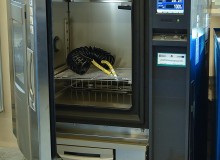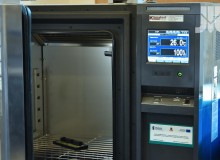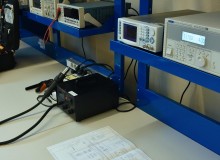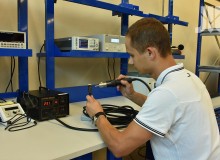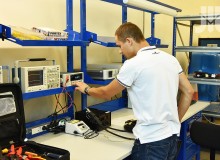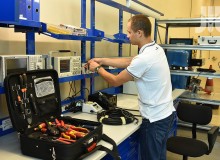Tests of electrical parameters
The tests performed at this test stand make it possible to design and optimize electrical
and electronic systems.
Equipment and parameters:
CLIMATIC CHAMBER:
• test temperature range: –40 °C to +150 °C
• chamber capacity: 110 l
• digital control of thermal profiles
GENERATOR:
• two powers supplies enabling the creation of a symmetrial power supply for systems with digitally
regulated voltage and current in the range of 0-60 V and 0-50 A and accuracy of 1 mV and 10 mA
• generation of electrical test signals (sine, rectangle, impulses) within the range of 20 MHz at amplitudes
of 20 V with the rectangular signal rise speeds of maximum 40 ms
OSCILLOSCOPE:
• digital oscilloscope Tektronix-type allows observation measurment of signals with a maximum frequency
of 300 MHz
DIGITAL MULTIMETER:
• measurement of DC and AC currents within the range of 1000 A
• precise measurement of currents, voltages, and resistances (10-5 accuracy, measurement of current
intensity in the range of 10 A with the accuracy of 1 μA, voltages in the range of 1 kV with the accuracy
of 1 μV, resistances in the range of 200 Ω – 1 MΩ with the accuracy of minimum 1 mΩ
VIBRATION TESTS STAND
• tested component weight: 2 kg
• excitation of fluctuations within the range of 10-500 Hz with the amplitude of 0.5 mm and acceleration
of 30 m/s2
• excitation of fluctuations within the range of 20-300 Hz with the amplitude of 2 mm and acceleration of
150 m/s2
THERMOGRAPHIC CAMERA:
• thermovision measurement of working temperatures within the range from 10 °C to 650 °C
Application:
• testing correct operation temperature intervals
• testing resistance to temperature shocks and exposure to extremely high and low temperatures
• examination of the correctness and quality of assembly
• parametric testing
• analysis of correctness of operation algorithms
• making adjustments in the tested systems manufactured using the lead-free technology and assembled
using the SMT and THT
• testing resistance to disturbances connected with operational deficiencies
• testing resistance to vibration, overload and long-term disturbances
• testing temperatures produced during the equipment operations
Research and Development Center
- About the Center
- Accredited laboratories
- Test offer
- Material tests
- Non-destructive tests
- Power hydraulics tests
- Static and dynamic tests
- Axle tests
- Wheel tests
- Prototype testing
- Falling object protective structure (FOPS) tests
- Vehicle stability tests
- Fuel systems testing
- Electrical quantities tests
- Machine noise testing
- Environmental and climatic tests
- Chemical tests
- Approval tests
- CBR services
- Contact CBR


